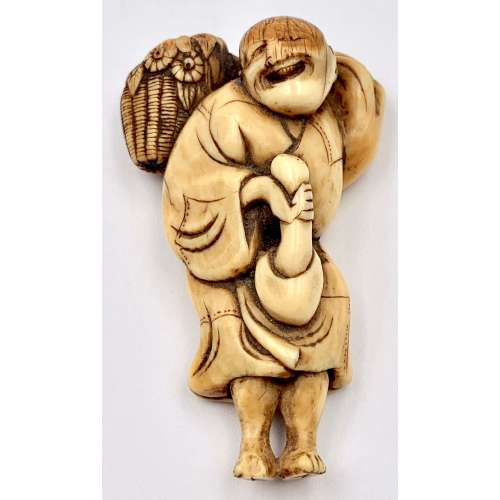Signed: Ichiyosai Kuniyoshi ga in a red cartouche and sealed with paulownia (kiri mon).
Date seal and double nanushi censor seals: Fuku & Muramatsu, 1853 (Kaei 6, 2nd month).
Size: Uchiwa-e (untrimmed fan print) 296 x 230 mm.
 SVJP-0303.2019 |

Signed: Ichiyosai Kuniyoshi ga in a red cartouche and sealed with paulownia (kiri mon).
Date seal and double nanushi censor seals: Fuku & Muramatsu, 1853 (Kaei 6, 2nd month).
Size: Uchiwa-e (untrimmed fan print) 296 x 230 mm.
 SVJP-0303.2019 |
![Bayros Zeichnungen. — Gala Verlag, Hamburg fur Fourier Verlag GmbH, Wiesbaden, 1987. — pp. 207. — 233 illustrations, essay by Wilhelm M. Busch. [Franz von Bayros Drawings].](https://varshavskycollection.com/wp-content/uploads/2021/02/LIB-2245.2019-a-scaled-500x500.jpeg)

Ivory netsuke with a design of a man (possibly - Ariōmaru) wrestling a giant octopus.
Circa 1850. Dimensions: 45.5 x 48.3 x 37.8 mmUnsigned.




Large iron tsuba with hammer marks on the surface, small oval opening to the right of nakaga-ana; yamagane fukurin chiselled with tortois shell diaper pattern.
Early Muromachi period (1393-1453). Size: 101.2 x 101.9 x 2.4 (center), 5.2 (rim) mm; weight: 148.4 g.![Memoirs, Illustrating the History of Jacobinism, written in French by the Abbé Barruel, And Translated into English by the Hon. Robert Clifford, F. R. S. & A. S. / 2nd edition, revised and corrected. Printed for the Translator. — T. Burton. London, 1798. — Vol. 1-4. Vol. 1: Part I. The Antichristian Conspiracy: pp. (xvi) 401; Vol. 2: Part II. The Antimonarchical Conspiracy: pp.479; Vol. 3: Part III. The Antisocial Conspiracy: pp. (xviii) 414; Vol. 4: Part IV. Antisocial Conspiracy; Historical Part: pp. (xviii) 601 [50].](https://varshavskycollection.com/wp-content/uploads/2021/02/LIB-2195.2019-scaled-500x500.jpeg)


![Оммер де Гелль [псевд. П. П. Вяземского]. Письма и записки. / Ред., вступ. ст. и прим. М. М. Чистяковой. Оформ. Н. П. Дмитриевского. // Серия: «Иностранные мемуары». Под общ. ред. И. Т. Смилги. — М.-Л.: Academia, 1933. — 469 стр., 8 л. илл., суперобложка. Тираж 5300 экз.](https://varshavskycollection.com/wp-content/uploads/2021/02/LIB-1930.2019-a-500x500.jpeg)

Netsuke with a design of a laughing peasant carrying a basket and holding a giant mushroom in his right hand.
18th century Dimensions: 55.7 mm tallUnsigned. According to Merrily Baird (Symbols of Japan, page. 93): ... This prominent use in the symbol-rich netsuke art form, however, reflects more their sexual symbolism than either their dietary appeal or interesting shapes. Mushrooms in Japan are generally a symbol of fertility, with some flat varieties, like shiitake, being associated with females. In contrast, the matsutake mushroom (Armillaria edodes) is a phallic symbol, as befits its thick, spearlike stem and the fact that it is consumed before cap opens.

Female Daruma Riding a Mushroom [女達磨]. Ippitsusai Bunchô (1765–1792). MFA impressions: 11.18513, 21.4758



Iron tsuba with hammer marked surface and design of a plum and cherry blossoms to the right of nakaga-ana in openwork (sukashi). Raised rim, typical to katchushi school. The thickness of the plate provides for later Muromachi period making.
Late Muromachi period (1514-1573). Size: 85.8 x 85.0 x 3.6 (center), 4.1 (rim) mm; weight: 136 g.



